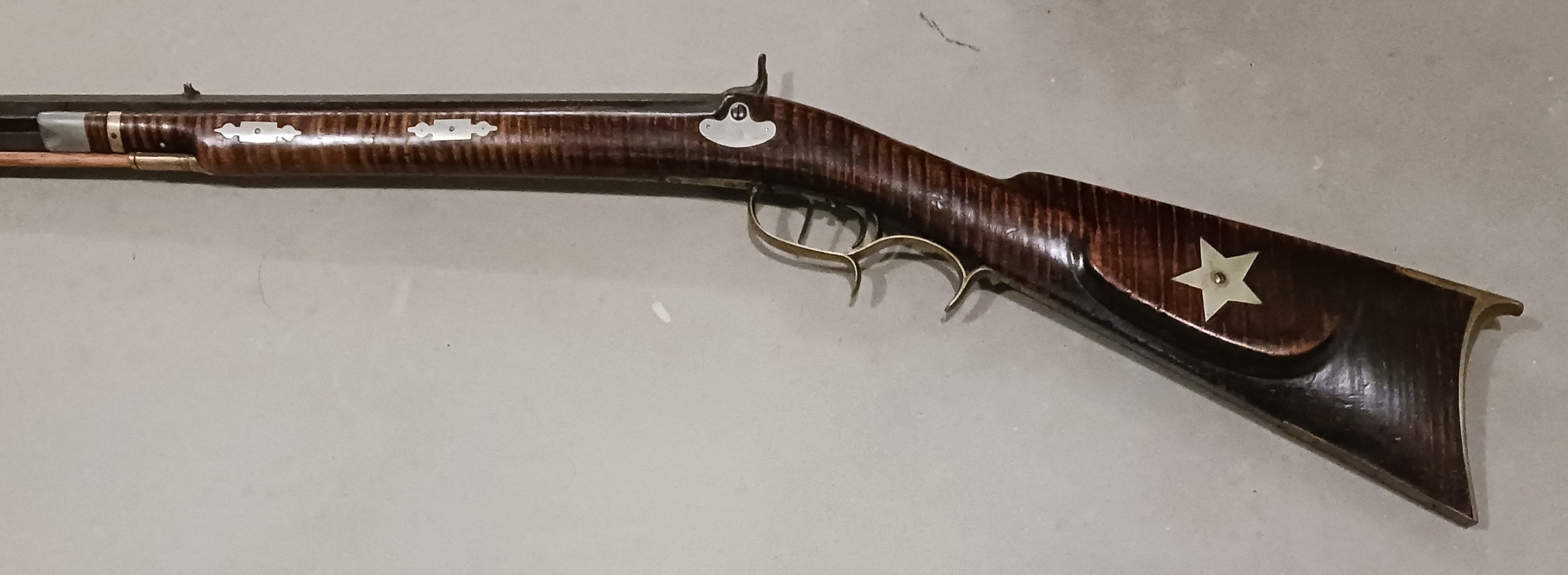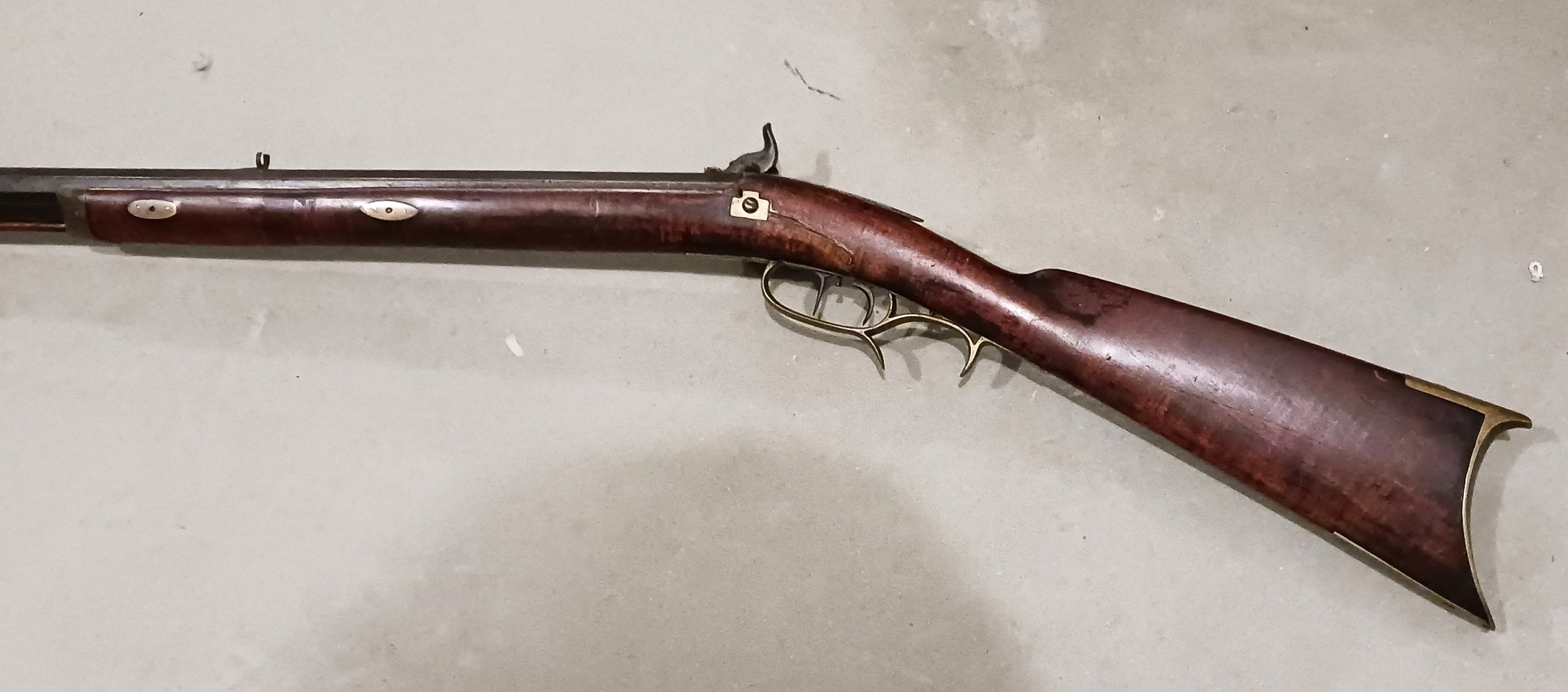Kentucky’s Mock Family of Gunsmiths ©
Foreword: The Mock family of central Kentucky has at least twelve members documented as gunsmiths. Daniel “Mauk” Sr. (1760-1825) of Virginia arrived in Nelson County, Kentucky, about 1789 and by 1792 was in the newly formed Washington County, made from the western part of Nelson County. He worked as a gunsmith in Springfield where at least two of his sons, Daniel Jr. and Reuben Mock, became well-known gunsmiths and passed the trade on to their sons. Reuben had three sons who were gunsmiths, Daniel J., George S., and James R. Mock. Two Mock rifles, one by George S. Mock and the other by younger brother James R. Mock, are illustrated here. They are good examples of Mock rifles made in central Kentucky in the 1840s and 1850s.
Figure No.1: Both George and James Mock signed their rifles in lightly engraved script with a somewhat loose and sprawling style of lettering. The “G. S. Mock” rifle’s signature is relatively clear, but the signature on the James Mock rifle, despite only moderate wear and oxidation, is difficult to read and not shown. Author’s collection.
George and James Mock: George S. Mock (1824-1900) and James R. Mock (1826-1887) were two of fourteen children born to Reuben N. Mock (1790-1876) and wife Elizabeth Seay Mock (1795-1878) in Washington County, Kentucky. Along with their older brother Daniel J. Mock (1814-1876), they learned the gunsmith’s trade from their father. George and James began working in the mid-to-late 1840s in nearby Nelson County. By the mid-1850s the brothers had separated with George going to Lebanon in Marion County on the east side of Nelson County, while James went to Elizabethtown in Hardin County on the west side of Nelson County. Both men were innovative, with George making early mattresses under his own patents for improved coil springs and mattresses that were separate from the springs [U.S. Patent No.257,176], while James patented an improved lock for repeating firearms in 1859 [U.S. Patent No.24,228].
Figure No.2: The tang on the earlier George S. Mock rifle is straight sided with a single bolt and small, rounded finial, a style commonly used in Nelson County in or near Bardstown by gunsmiths such as Bardstown’s well-known Jacob Rizer. The tang style suggests George made the gun while still living in Nelson County, which assists in dating the gun.
Figure No.3: The James Mock rifle has a longer, two-screw [actually a tang bolt with tail screw] tang that tapers to a point, more commonly seen outside of Bardstown and reminiscent of gunsmith David Wellers’ work in Elizabethtown, Hardin County, where James was working in the mid-1850s. Note the “leafy vine” tang engraving.
The Mock Rifles: George Mock’s rifle is several years earlier than James’ rifle based in its more robust butt stock, full cheekpiece, earlier style nose cap, larger lock bolt washer, and larger .36 caliber bore compared to James’ .32 caliber bore. It dates to about 1840-1845 while James’ rifle dates to about 1850-1855. Both men were trained by their father and worked with or near each other for their first 10-plus years, so their guns share a number of details. Butt profiles are the same, forestocks are double-keyed, guards are double-spurred with similar triggers, and both guns have three ramrod pipes and cast nose caps. But there are also significant differences. George’s earlier rifle has a large, oval style cheekpiece while James’ rifle lacks a cheekpiece. George’s rifle has a typical Kentucky-style nose cap set several inches past the rear ramrod pipe, while James’ rifle has a generic cast nose cap used as the rear entry pipe. Wood quality also differs, with the earlier rifle having well-figured curly maple while the later rifle was stocked in faded curly maple. The earlier rifle has a larger barrel and bore, but its barrel is about 4 inches shorter than the later rifle’s barrel, perhaps to reduce weight. James’ later rifle, despite its significantly longer barrel, is the lighter and easier to handle of the two guns.
Figure No.4: The George S. Mock rifle is half-stocked in fine curly maple with a double-keyed forestock, a rare detail on central Kentucky guns. The nose cap is located several inches past the rear ramrod pipe in typical Kentucky fashion, and the gun has the expected three ramrod pipes commonly used in/near Nelson County. The German silver inlays are not engraved, but they add interest to the dark stock wood. Barely visible is a “cutlass” inlay in the center of the butt, almost lost in the glare. Barrel: 41-1/2 inches long, .36 caliber bore. Author’s collection.
Figure No.5: The rear of the George S. Mock rifle has a well-formed, rounded cheekpiece with a large star inlay. The rifle is nicely stocked and has a decorative brass band between the nose cap and rear ramrod pipe. While not elaborate, the gun is reasonably well decorated, a vestige of the late Bardstown School.
Two details on the Mock rifles deserve further discussion: 1) the double-keyed forestocks, and 2) a generic cast nose cap as the entry ramrod pipe. Double-keyed forestocks are rare on guns from Kentucky’s Bluegrass region. When seen, they often suggest the rifle was made closer to Missouri where later style double-keyed “plains rifles” were being made by St. Louis gunsmiths such as the Hawken brothers and Dimmick. A few Louisville gunsmiths made plains-style rifles for the Ohio River traffic heading west, but inland gunsmiths usually followed the more traditional styles of Kentucky gunmaking. The generic cast nose cap on James Mock’s later rifle is also unexpected. Most Kentucky gunmakers continued to use the traditional style of nose cap set several inches past the rear ramrod pipe until well after the Civil War. James’ use of the later style cast nose cap/entry pipe was a progressive move, perhaps a result of his innovative ways, but it strayed from the traditional form of most mid-century half-stocked Kentucky guns.
Figure No.6: The James R. Mock rifle is similar to the earlier George S. Mock rifle in its butt architecture, guard and triggers, double-keyed forestock, cast pewter nose cap, and three ramrod pipes. However, the design of the rear ramrod pipe is different. Here the later style cast pewter nose cap serves as the rear ramrod pipe, breaking from the Kentucky tradition of nose caps being placed several inches past the rear ramrod pipe. Butt height is about the same as on the earlier George S. Mock rifle, but the longer barrel on this rifle makes the butt look smaller. Barrel: 45-1/2 inches long, .32 caliber bore. Author’s collection.
Figure No.7: The James R. Mock rifle lacks a cheekpiece, and its lock bolt washer is small. However, two German silver inlays at the barrel keys/pins add a touch of decoration to the gun’s otherwise plain back side. The stock has almost no visible figure in its curly maple, with curl only appearing in a few small areas.
Summary: Three generations of Mock gunsmiths made good quality guns for almost a century in central Kentucky. Early flintlock guns by the Mocks are rarely seen, but guns from their later generations survive in greater numbers and offer today’s students and collectors interesting examples of the quality and innovation the Mock family brought to Kentucky’s early firearms industry in the mid-1800s.







